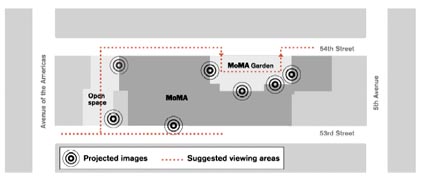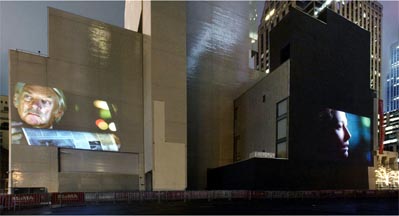“Danger, Will Robinson” squawked the robot. Now, I walk into the danger of critiquing something I have never seen, but many others have – the Sleepwalkers video projections by Doug Aitken on MoMA in NYC. But projecting yourself into the reality of some other place is a primary function of this Blog and is the virtual/physical internal struggle of the Internet itself.
This entry is caused by comments sent to me by Tim Barrus of Cinematheque Films. Barrus produces video art on YouTube. The comments from Barrus, myself and AJ blogger Tyler Green are reposted in the “CONTINUED READING SECTION”. Thank you very much, Mr. Barrus. I encourage others to speak their minds to me.
Barrus had responded that YouTube is a public territory where public art exists. But unlike the public art of physical public space, YouTube is a virtual space of reciprocity between creative people. As I see it, public art in physical space is primarily “show and see” and in the best situations “show and show to others”. It is a presentation, not an invitation to respond creatively.
On the other hand, Barrus argues that YouTube is a public space where public art is only as valuable as the creative response from others. As I see it, the low cost and free use of public space on YouTube permits this indirect creative interchange, whereas 95% of physical public art actually discourages creative interchange in the public space. Vandalism (unauthorized physical changes) is illegal. On YouTube, the concept of vandalism makes no sense.
But Barrus writes because MoMA is stealing free space on YouTube to advertise, not participate. He is absolutely right. The MoMA YouTube video is a 60 second “trailer”. MoMA could have presented one random version of the whole 13-minute work. MoMA could have streamed the work every night from multiple, building-mounted video cameras as used in nearly every major construction project in the nation. Instead we are presented, not invited. Perhaps Barrus fears that vandalism may become a YouTube concept.

In my virtual chair imagining 53rd and 54th Streets of Manhattan, “markart” on flickr.com showed me the story because MoMA and Creative Time websites present only one photograph of the work from the street and this strange map describing how to the view the work. The instructions seem contradictory to Roberta Smith of the NY Times as she paraphrased Guy Debord, “simply to walk or ”drift” through the city, open to accepting fleeting experiences as art”.
BLOG UPDATE: Mark Barry sent me this link to Creative Time’s intern Brent Burket’s blog with daily images and comments. Thank you! Click here to truly experience the work.

This is only spatial information because the directors, curators and writers are most interested in Aikten’s video work, not the space and not the city. This makes me think that the maximum achievement might be as Creative Time curator Peter Eleey calls it – a drive-in cinema for pedestrians. Not a very high goal, since every city in America has an outdoors “lawn chair” cinema in the warm season.

In addition to Eleey’s statement in the MoMA press release, quotes from the directors of Creative Time and MoMA match the language of the junior public art administrator in any medium American city. Creative Times’ Paternak: “…flow of cinematic images, and making architecture come to life with rhythmic human presence, for the public to enjoy.” And MoMA’s Lowry: “Sleepwalkers will be easily accessible to a broad and diverse audience of New Yorkers and visitors to the city, who can engage directly with an artwork in a vital and unexpected context.”
Something tells me that the lack of response on the Internet and media is in part due to the low institutional imagination for participation. Yes MoMA and Creative Time have made another advance in technical support for the artist video projects, but we hold these institutions to higher standards. I remember the grassroots thrills of Krzysztof Wodiczko projections on monuments in the 1980s. I have been in full body experiences such as the annual gigantic horizontal fireworks display on the Edo River in Tokyo. Light-up Tampa and the UK projections of David Mach wake us up on the street. We expect Sleepwalkers to be a work of space in addition to a work of the mind.
Regarding the mind, one attribute of Aitken’s work apparently reinforces a common myth of NYC. Eleey: ..engages the turbulence of city life.. MoMA’s Biesenbach: ..engaging the audience as nocturnal movers.. Smith:.. ode to the city that never sleeps… Restating and remaking the myths of a specific place is one of the finest goals of public art.
Back to Barras. In the 1980s in Soho, I went to party sponsored by “Red Spot”. The artist on the fifth (?) floor loft handed out glass slides and glass paint. With his large slide projector, handmade miniature works became gigantic images on the dirty wall across the parking lot. Using city space with an invitation to participate. I don’t know about Aitken’s work, but below on that Soho street, Gibold became reality: “simply to walk or ”drift” through the city, open to accepting fleeting experiences as art”. The Red Spot images flickered and disappeared making me love – even more – that street, that city.
PS. Another video projection work that I never saw, but always enjoyed in my imagination is Chris Doyle’s LEAP. With the help of Creative Time in 2000, images of New Yorker’s jumping were projected on the former white façade of Edward Durell Stone 1964 façade on 2 Columbus Circle.
Photographs by Fred Charles from MoMA / Creative Time website.
Continued Reading features comments from Barrus, Weiss and Tyler Green
Tim Barrus Comment to Glenn Weiss
Cinematheque Films
I’m still not sure what public art is. Doug Aitken teams up with MOMA
to exhibit his video images that seem to be comparable to a silent
movie but this time projected in large images on the walls of
buildings. Obviously, this is “public art.”
But it gets complicated.
To “spread the news” of this event, MOMA creates a YouTube channel.
But it doesn’t behave anything like a YouTube channel. It behaves
more like a traditional ivory tower. YouTube is about sharing video
and sometimes videoart. Which can be good or bad as this is the
public realm.
It is sad that MOMA only uses YouTube to speak down to us (lowly
peons) and the sharing is most definitely one way. We become
consumers and MOMA becomes an advertiser. What does this have to do
with art. It’s like taking the paradigm from the older institutional
role (where the institution speaks to individuals) and inserting it
into a place designed not simply for even two-way communication, but
for a zillion-way communicative PROCESS, and MOMA’s patriarchal view
that Youtubers exist to be advertised to with tidbits is a relic, and
arrogant. MOMA could be using that space with real public art but no.
We are spoken “down” to and at; this is neither art nor communication.
MOMA needs to leave YouTube and go be pleased with its royal self
behind its royally closed doors.
This isn’t public art. Once again, it’s art for the MOMA crowd; the
wealthy and the arrogant.
Glenn Weiss response to Tim Barrus
Aesthetic Grounds
I can’t burn the book. Victor Hugo wrote, the Book Killed Architecture. YouTube Killed the Book? Progress doesn’t matter. The old hang around. The new get started.
Public art is the artwork imposed on the innocent passing through space. Virtual space is as good as any other space, except the innocent one is absurdly impossible.
Aitken on a wall is very straightforward imposition on the streets of NYC. MOMA in YOUR YouTube space is just as straight forward and expected. Gentrification is an artistic tradition.
Tim Barrus response to Weiss
Cinematheque Films
Sadly, the minute the neighborhood becomes gentrified, the real
artists who used to live and work there can’t afford the rent. One
moves on. There’s usually an edge somewhere if you can manage to hang
on tight enough and not get pushed into some great abyss. YouTube did
have something of an edge once, some of us lived and worked there,
but now I feel the gravitas of the pull below. So MOMA is at YouTube.
What of it. What will we have lost.
Reciprocity.
AJ Post By:
Tyler Green
January 8, 2007
Internet video: Museums
About a year ago I was talking with an ex-museum-director friend about video art and the internets. He told me that he was surprised that more video artists hadn’t taken advantage of the internet as a way of getting their work seen. “I keep waiting for video art to pop up on iTunes,” he said. “And I check at least once a week.”
Ever since that conversation I’ve been keeping an eye on sites such as Google Video and YouTube for any sign that new media artists are looking for broader audiences via the web. I haven’t found much — but that could also be because I don’t know where to look. (Anyone know of a good blog with this stuff?) So let’s start with what two museums are doing:
The Museum of Modern Art has recently started a YouTube channel called MoMAvideos. Given the museum’s partnership with Creative Time on Doug Aitken’s sleepwalkers, two ‘trailers’ for Aitken’s MoMA projections are the channel’s first programming — and they’re well worth a look. (The trailers are also on Google Video, and MoMA has an Aitken site on moma.org.)
So far the museum doesn’t have any plans to post works from its collection on YouTube, to commission work that would be shown there, or to launch a video art ‘exhibition’ on YouTube… but that’s not to say those things won’t happen in the future, I’m told.
One reason to expect MoMA to be among the first to explore online possibilities: MoMA recently created a Department of Media, and put curator Klaus Biesenbach in charge of it. That means there’s a place in MoMA’s hierarchy to explore outside-the-box ideas such as this. For example: MoMA may post video of Aitken’s sleepwalkers as projected on its buildings once the exhibition starts on Jan. 16. After all, dozens of New Yorkers will probably post their own homemade sleepwalkers vids on YouTube, so why shouldn’t the museum do so itself? (That’s a MoMA-distributed rendering of sleepwalkers at right.)
Another benefit of using a YouTube channel instead of putting this all on the museum’s own website: It costs MoMA virtually nothing to put video on YouTube. If MoMA had to host the video and pay for the bandwidth, who knows how much that could cost.
Tim Barrus to Tyler Green
Cinematheque Films
Tyler,
People think I am insane for responding to ideas put forth at Art Journal, (I’m just a crank) but you hit on something — a quote — important to artists: Art gets made in places by people interacting with people. No one sees the relevance of this (I do not mind being alone) in the presence of MOMA on YouTube. It’s true that art is often something I do alone but alone is relative and not really a complete vacuum. Interacting with Other People not only kicks ideas into high-drive, but it causes one to ponder, too. There is value in that and in seeing what Other People are doing with the PROCESS.
There is not a whole lot of art on YouTube. It is very much a PUBLIC space. The public is THERE. But there are people experimenting with VideoArt on YouTube and their work, if you can find it as they tend to not spend their time promoting their channels in favor of creating what they create, is very definitely “the product and the place” for VideoArt. Both the piddling and the profound.
Enter MOMA: The Museum of Modern Art simply uses YouTube as a space for advertising. They have no idea how this flies in the face of the rest of us but the numbers are interestng. I myself do not spend time generating numbers but I do interact with other videoartists. I note 14-year-old boys playing with their daddy’s cameras at YouTube with more numbers than MOMA. For such a huge institution, for all that money, their numbers are low and there is a reason for this. MOMA is not good for art.
This is very sad. They have so much they could contribute but like most other ivory towers they cling to “what they own” (that seems to be the point of art) and the old paradigm where the audience comes to the museum (and pays twenty bucks). We bow before le MOMA.
MOMA like everyone else at YouTube has a channel. They post tidbits there. We are supposed to be in awe and impressed.
They do not interact with any of the rest of us. They have nothing to say. They have nothing to contribute to the PROCESS of art. Their presence such as it is is arrogant and disturbing. The attitude is that “we are bigger and better than the rest of you peons and we are where the REAL art is.” I would dispute that. When you see who is attracted to MOMA at YouTube, one notes they are people who have already been to Mid-Town. No new blood. The attitude is: we may be here but we don’t need you.
This is complete bullshit. What they need is relevance.
MOMA is just another institution and what they are selling is what they collect. The success and attraction of YouTube is based on reciprocity. Not just file sharing but the reciprocity of creating art. PROCESS. This is why we are there. To interact with people who are involved with one another IN THE PROCESS. None of us just sit there like MOMA and preen with what we own. We are making things. MOMA’s presence is offensive. It isn’t good for art because it makes art seem like another dead thing. Not something infused with life. Not relevant.
YouTube succeeds because it is about people interacting with people. They do not have a clue at MOMA as to what this means and certainly not to art and certainly not to art that can be accessed by the public.
An insitution like MOMA looms over YouTube like a behemoth monster that consumes (or advertises like toothpaste) but contributes nothing. Those of us making VideoArt aren’t REAL artists. We’re just part of the great unwashed (and stupid) public. MOMA is better than we arand what we do is not relevant to “real” art. Real art is expensive and collected and displayed to people who can afford to see it (I would rather buy art supplies).
I would suggest it is MOMA that is irrelevant in a place where artists are interacting with other artists and it’s important. To art. Too bad MOMA can’t see it or be a part of it — they could be interacting but they are making the decision not to do so — but that seems to be the nature of American institutions. They can’t change. It’s all one way and there is no reciprocity. In the face of new paradigms, they’re completely lost.
This is the old paradigm and it’s obsolete. The museum as the beginning and the end (and what they own and display being the point). MOMA may be at YouTube but it doesn’t mean anything and like most behemoths, it will quickly become irrelevant (it already has) in a place where relics are an odd fit, indeed. Many of us waited around to see what they would do on YouTube and they let us know. They did nothing.
Tim Barrus
Cinematheque Films
